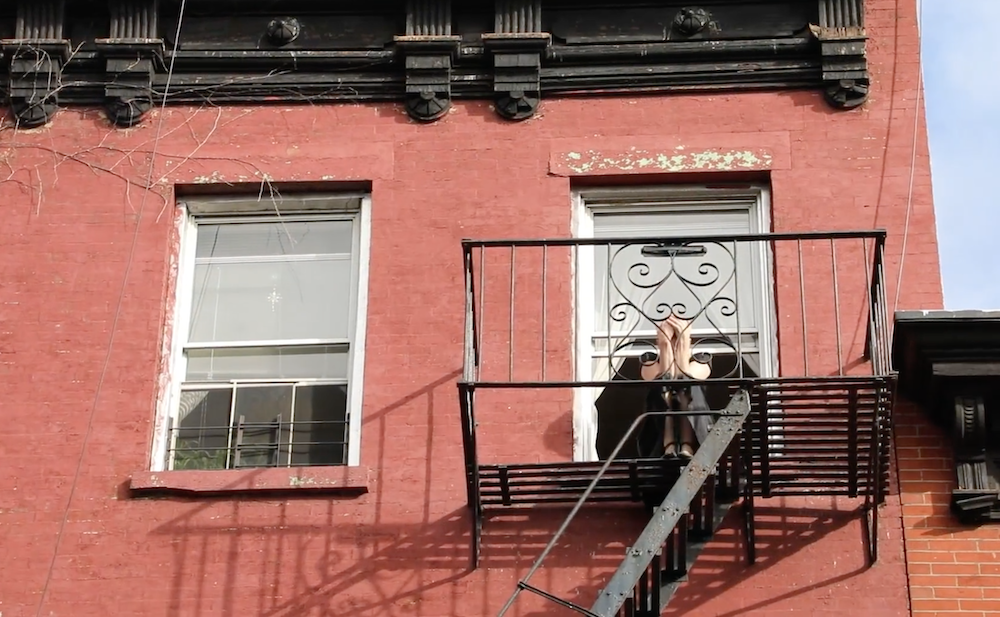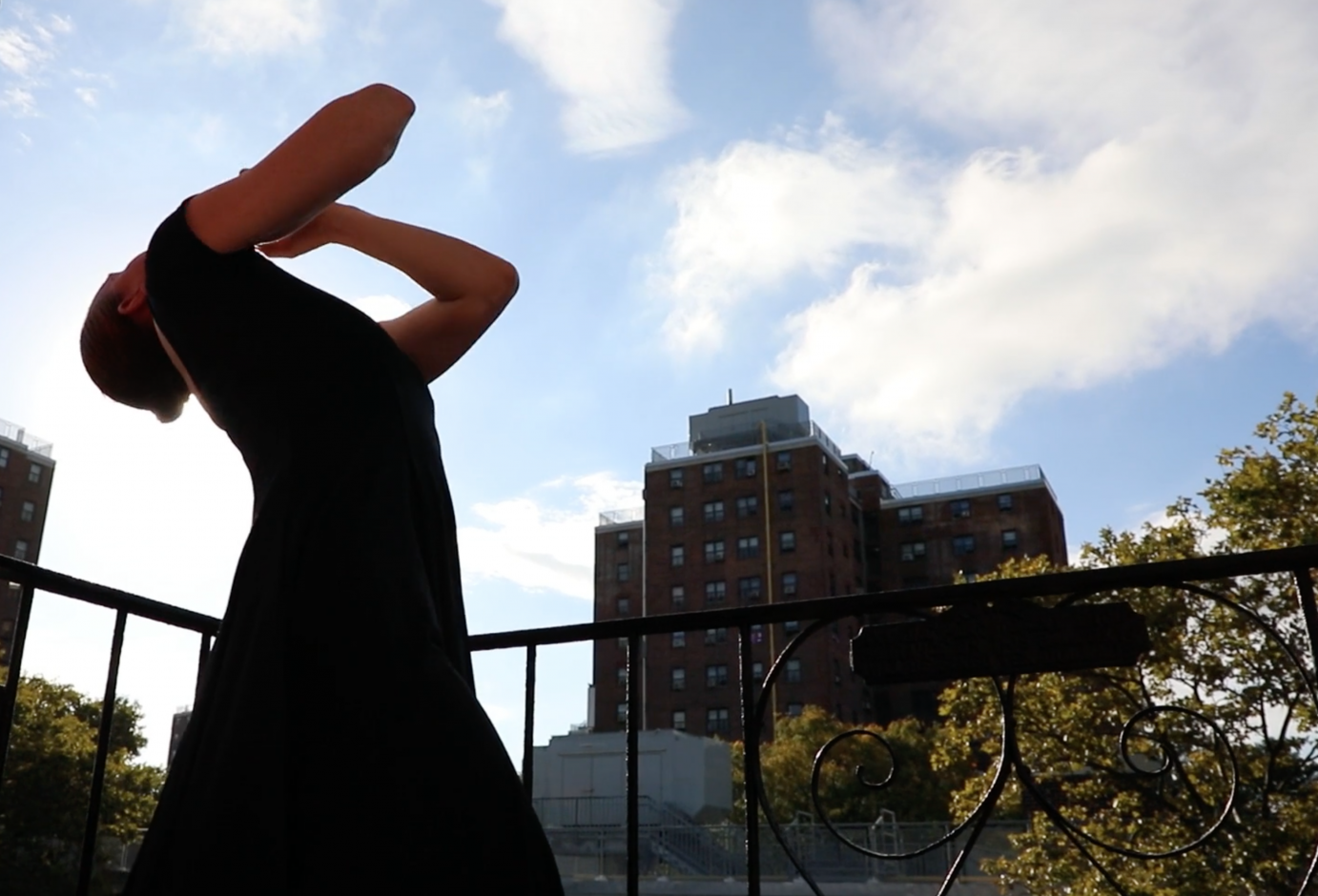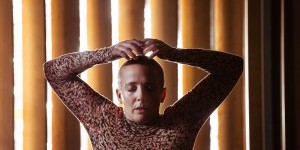SOCIAL DISTANCE DANCE VIDEO: Chriselle Tidrick's "The Limits of Escape"

"The Limits of Escape" Chriselle Tidrick: Choreographer/Performer, Roy Szuper; Filmmaker/Director, Daniel Roumain: Musician/Composer, Andrew Sterling: Editor
Christine Jowers for The Dance Enthusiast: Chriselle, I'd like to know what drew you to your fire escape as a stage for dance?
Chriselle Tidrick: When New York City shut down in March, I wrestled with the shock of the deaths happening around us, the sudden collapse of the performing arts, and selfishly, my lack of access to the circus studio to continue my aerial training and aerial dance choreography projects. I transitioned to online dance classes and solo dance training at home and felt grief for what I perceived to be the loss of my creative life.

One evening, as I did ballet barre while looking out the window, I suddenly wondered if any of my neighbors could see me and, if so, what it was like for them to watch someone doing ballet in their apartment. It was this sudden shift of perspective from inside looking out, to outside looking in that made me think about the space available to me in a different way. I suddenly realized I could choreograph a piece for my fire escape.
I see the piece at first as revealing tension, anguish, restriction, which opens up to exploration as you use the balcony as a partner, allowing your body to elongate and fill the constricted area. I felt almost as if you were dreaming of being somewhere else.
The Limits of Escape is an outlet for my own feelings of frustration, grief, and isolation in response to the events of spring 2020-both the effects of the pandemic and the multiple manifestations of racial inequity in the U.S. However, when I am performing I feel that I am in the role of a character who is going through her own process with these emotions. Her situation somehow feels much more desperate than my own.
She starts alone in grief and tears, looks at her surroundings with fear and a sense of overwhelm, and gradually begins searching for a way out of her situation. At one point, she feels close to freedom as she moves easefully from place to place, but ultimately she remains trapped by the circumstances of the moment.
Escape is never as simple as it seems, and the things she has experienced will always be with her. As the awareness of the pain of the moment returns, she ends up back where she began-- grieving-- but this time with a sense of the possibility that lies on the other side of pain.

As you observed, I use the fire escape in many ways. I really like how you see it as my partner. It restricts me, it supports me, it protects me, and in moments, I see the vertical bars as prison bars. I feel fortunate that my fire escape is comparatively large. In fact, it's the largest of my building's fire escapes. Also, because I live on the top floor, the top of the fire escape is entirely open, and that allows for more freedom of movement and makes it possible to generate those feelings of openness and connection with the sky.
How did you choose your collaborators?
There's a story behind each of my collaborators.
First, I want to say that Daniel Roumain is one of the most gifted contemporary composers around. For your readers who haven't heard of him, they should definitely check out his website (https://www.danielroumain.com/) and get to know his music. There is such sensitivity and depth of feeling in everything he composes, and the expressiveness he brings out of his violin really touches me.
I first met Daniel many years ago (more than 20 years ago, if I'm forced to be honest) when he was an accompanist at the José Limón studio and I was a student dancer. I fell in love with his music then, and some years later I saw him performing with Bill T. Jones' company. I have followed his career off and on since then, and I think I own every piece of his music that it's possible to buy. The interesting thing about my fire escape piece is that I actually started out using a different piece of music by a different composer. Parts of it worked well, and parts of it just made me feel choreographically stuck. In the midst of all this, I messaged Daniel in response to a post on his Facebook page to let him know how much I loved his music. We reconnected, and he offered to let me use a piece of his music for the piece I was developing on my fire escape. I revisited the recordings I had, and I found the perfect music for the piece. Creating the rest of my choreography was easy after that.
As for the film component, I met Roy Szuper, the filmmaker/director, through my old job taking tickets at the Met Opera. He works in the box office, and we sometimes had a chance to chat at work. We had briefly discussed a film collaboration some years ago, but that never came to pass. As “The Limits of Escape” was coming together, I contacted Roy to see if he had any interest in collaborating with me on this project, and he agreed. I have no experience in filmmaking, and I am grateful that Roy has a lot of experience and an eye for storytelling.

I choreographed the piece with the idea that it would be viewed from the outside, but Roy really liked the idea of doing some of the shooting from inside the apartment looking out. I am glad he pushed me on that point, because the result is a film that can be seen both from the perspective of the observer looking in and from the perspective of the character looking out onto the world.
Roy came to my apartment to shoot the piece in September when COVID cases were fairly low. We were still very careful during the shooting process, and thankfully neither of us got sick. The editor, Andrew Sterling, is a friend of Roy's and someone with whom Roy has worked in the past. He and Roy worked together on how the shots for the film should be put together, and Andrew made the magic happen. We went through a couple of rounds of revisions, and I'm very happy with the final version.
Did the work develop easily and naturally? What were your challenges, or suprises?
The creative process actually started in writing. I had very clear ideas for imagery and quality of movement for the piece, and I spent some time writing out the elements I wanted to include. I initially envisioned this as a longer piece with different sections for different types of emotional expression, but as the work evolved, it made more sense to flow between emotional states and qualities of movement.
The first phase of my choreography took place in my living room with the initial piece of music and a step stool which I imagined would be similar to my window ledge. Once I went outside onto my actual fire escape, I discovered that much more movement was possible than I imagined. I spent a lot of time improvising and recording those improvisations. Watching my videos helped clarify the trajectory of the piece. As I mentioned, I became very stuck choreographically with the first piece of music I was using. As soon as I switched to the two pieces by Daniel Romain that I ended up using, the movement I had been playing with made sense, and I understood more clearly how everything should fit together.

I especially loved playing with the different parts of the fire escape during my creative process. The space both limited movement and created interesting possibilities for movement, and it was fun figuring out how to make use of all the space available out there.
Was it dangerous performing on your fire escape, and I wonder, is it the most unusual space you have ever performed?
The potential dangers were definitely on my mind. In a lot of cases, you can see that I use multiple points of support. My idea was that this would both distribute my weight, and it would give me a better chance of having some point of support if part of the fire escape failed. There are a couple of moments when I'm balanced a bit precariously. I always made it a point to take my time through those moments to make sure I felt comfortable. My experience as an aerialist was a big help, because it made me think about the fire escape as apparatus, and it helped me consider potential points of weakness or potential failure in the structure.
I have performed in a lot of strange places over the years-- so many that I'm not sure I even know what's strange anymore. I have performed in people's fancy homes, in a cricket stadium, as part of a runway show, in parks, on Miami Beach, at museums and zoos, and next to a waterfall in Costa Rica.
How have you kept emotionally, physically, and spiritually healthy during this time of pandemic and upheaval?
I think my experience isn't markedly different from that of most people. I definitely have my ups and downs. I was very depressed in the spring as it became clear that a return to performances and aerial training weren't going to happen any time soon. I also felt really guilty for having these feelings, because there were so many people dealing with so much worse.

For me, getting into a regular routine was essential. I took regular online dance classes, yoga classes, and gyrokinesis classes. I also enjoyed giving myself ballet barre, because I could work on different aspects of technique that I couldn't necessarily focus on during a live class. Movement made me feel more like myself, and shifting my focus back to dance felt oddly like coming home. Meeting with my regular meditation group every 6 weeks or so was also a big help.
At the same time, I'm not going to deny participating in the trend of making baked goods and expanding my cocktail repertoire. Once the shock of the ways in which my life had changed wore off a bit, it was actually nice being home with my husband on a regular basis. For much of our marriage, we have struggled to get enough time together.
What do you most look forward to doing when this period is over and the pandemic is behind us?
I can't wait to go back to the theater. I really miss regular trips to various NYC theaters to see dance, circus, classical drama, music, physical theater, and maybe even a musical or two. I have dreams sometimes about going to the theater.
I'm also really excited about performing aerial dance work again. After being away from training for 10 months and feeling worried that that part of my creative life might have come to an end, I am thrilled to be included in Aerialists and Acrobats at City Point-- a residency for circus artists.
I spend much of my residency time doing aerial conditioning, and I have thankfully discovered that my strength and technique is gradually coming back. I have already started developing a new aerial dance piece. It's definitely different from the one I envisioned pre-pandemic, but working without expectations has actually given me some extra freedom to play. I can't wait until it's possible to share it with an audience.

Headshot Courtesy of Aritist














